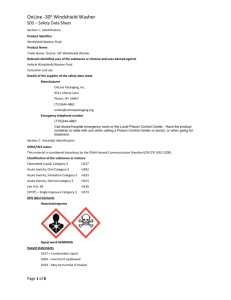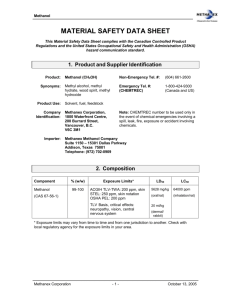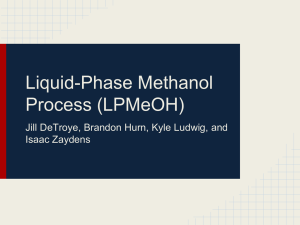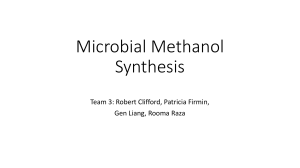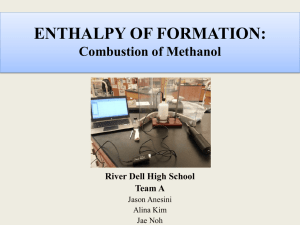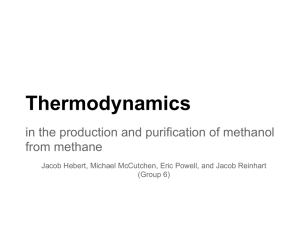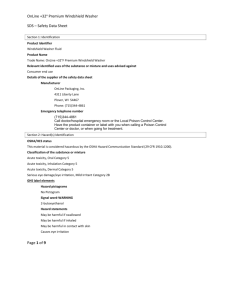25 Premium Windshield Wash SDS
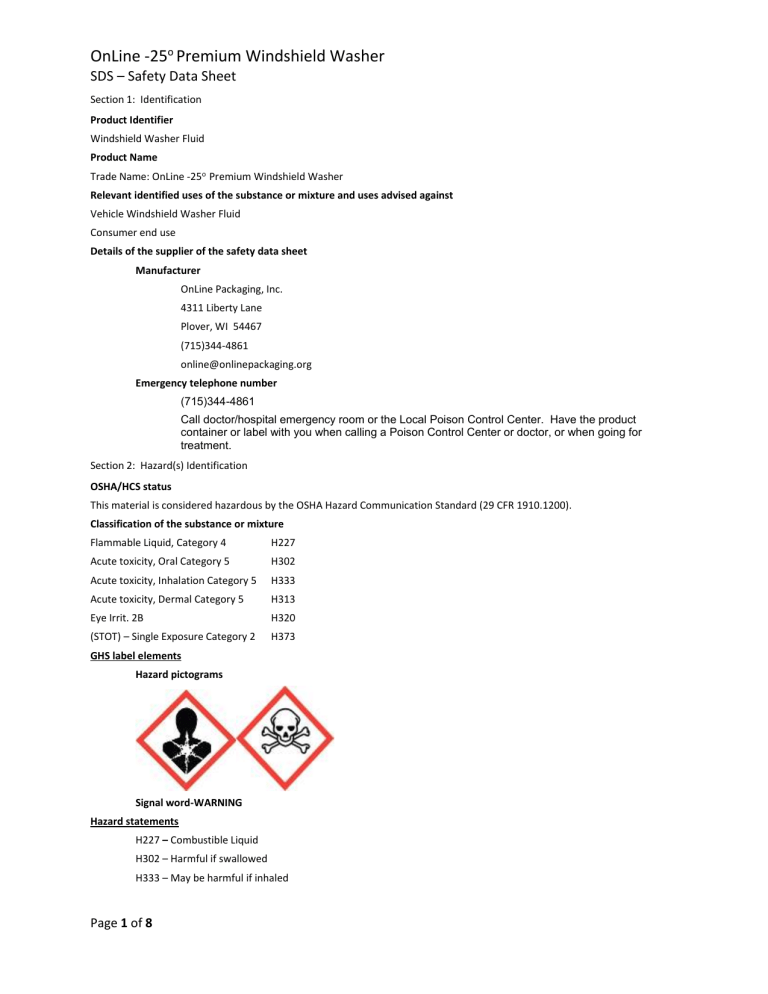
OnLine -25 o Premium Windshield Washer
SDS – Safety Data Sheet
Section 1: Identification
Product Identifier
Windshield Washer Fluid
Product Name
Trade Name: OnLine -25 o Premium Windshield Washer
Relevant identified uses of the substance or mixture and uses advised against
Vehicle Windshield Washer Fluid
Consumer end use
Details of the supplier of the safety data sheet
Manufacturer
OnLine Packaging, Inc.
4311 Liberty Lane
Plover, WI 54467
(715)344-4861 online@onlinepackaging.org
Emergency telephone number
(715)344-4861
Call doctor/hospital emergency room or the Local Poison Control Center. Have the product container or label with you when calling a Poison Control Center or doctor, or when going for treatment.
Section 2: Hazard(s) Identification
OSHA/HCS status
This material is considered hazardous by the OSHA Hazard Communication Standard (29 CFR 1910.1200).
Classification of the substance or mixture
Flammable Liquid, Category 4 H227
Acute toxicity, Oral Category 5 H302
Acute toxicity, Inhalation Category 5 H333
Acute toxicity, Dermal Category 5
Eye Irrit. 2B
H313
H320
(STOT) – Single Exposure Category 2 H373
GHS label elements
Hazard pictograms
Signal word-WARNING
Hazard statements
H227 – Combustible Liquid
H302 – Harmful if swallowed
H333 – May be harmful if inhaled
Page 1 of 8
OnLine -25 o Premium Windshield Washer
SDS – Safety Data Sheet
H313 – May be harmful in contact with skin
H320 – Causes eye irritation
H373 – May cause damage to organs through prolonged or repeated exposure
Precautionary statements
PREVENTION:
P101 – Keep out of reach of children.
P233+P234 – Keep container tightly closed. Keep only in original container.
P260+262 – Do not breathe mist, vapors’, spray. Do not get in eyes, on skin or on clothing.
P280 – Wear protective gloves, eye protection, face protection.
P264 – Wash hands and other exposed areas thoroughly after handling.
RESPONSE:
P301+P310 – IF SWALLOWED: Immediately call a POISON CENTER or doctor/physician.
P305+P351+P338 – IF IN EYES: Rinse cautiously with water for several minutes. Remove contact lenses, if present and easy to do. Continue rinsing.
P302+P352+P332+P313 – IF ON SKIN: Wash with soap and water. If skin irritation occurs: Get medical advice/attention.
P304+P340+P314 – IF INHALED: Remove victim to fresh air and keep at rest in a position comfortable for breathing.
Get medical advice/attention if you feel unwell.
P309+P310 – If exposed or you feel unwell: Immediately call a POISON CENTER or doctor/physician.
STORAGE:
P403+P233 – Store in a well ventilated place. Keep container tightly closed.
DISPOSAL:
P501 – Dispose of contents/container in accordance with all local, state, regional and national regulations.
Hazards not otherwise classified
Product is stable.
Section 3: Composition/Information on Ingredients
Substance/mixture: Mixture
Chemical name: Methanol (Water and Methanol mixture)
Other means of identification: No
CAS number/other identifiers
Ingredient name % (WT.)
Methanol
Section 4: First Aid Measures
34-36
CAS number
67-56-1
Description of necessary first aid measures
General: This product contains Methanol. Cannot be made non-poisonous. If swallowed/ingested immediately call a
POISON CENTER or doctor/physician. Have the product container or label with you when calling a POISON CENTER or doctor/physician or when going for treatment.
Ingestion: If person is conscious give 1 or 2 glasses of water. Never give anything by mouth to an unconscious person.
Then call POISON CENTER or doctor/physician immediately for treatment advice/method to induce vomiting. Get
prompt medical attention.
Eyes: Hold eye/eyes open and rinse slowly and gently with water for 15-20 minutes. Remove contact lenses, if present, after the first 5 minutes, and then continue rinsing. Call a POISON CENTER or doctor/physician for treatment advice if irritation persists.
Skin: Take off any contaminated clothing. Immediately rinse skin with plenty of water for 15-20 minutes. If skin irritation occurs call a POISON CENTER or doctor/physician.
Page 2 of 8
OnLine -25 o Premium Windshield Washer
SDS – Safety Data Sheet
Inhalation: Remove person to fresh air and keep at rest in a position comfortable for breathing. Get medical advice/attention if person feels unwell.
Most important symptoms/effects, acute and delayed
Potential acute health effects
Ingestion: May be fatal or cause blindness if swallowed. Other symptoms include irritation of mucous membranes, nausea, headache, vomiting, dizziness, and coordination problems, blurred or snowy vision.
Eye Contact: Causes eye irritation including pain, blinking, redness and sensitivity to light.
Skin Contact: Repeated or prolonged contact can result in skin absorption which may cause irritation, itching, dermatitis.
Inhalation: Symptoms may include dizziness, headache, nausea and loss of coordination along with sore throat, shortness of breath and coughing/congestion.
Indication of immediate medical attention and special treatment needed, if necessary
Notes to physician
This product contains Methanol. Cannot be made non-poisonous and may be fatal or cause blindness if swallowed/ingested. There is a need for rapid treatment of any ingestion exposure. Over exposure may aggravate acute or chronic asthma, emphysema and bronchitis.
Specific treatments
N/A
Protection of first-aiders
N/A
See toxicological information (Section 11)
Section 5: Fire Fighting Measures
Extinguishing media
Suitable extinguishing media
SMALL FIRE: Use DRY chemical powder, CO
2
or appropriate foam.
LARGE FIRE: Use water spray, fog or foam. Do not use water jet.
Unsuitable extinguishing media
None known
Specific hazards arising from the chemical
Vapors may travel back to ignition source. Closed containers exposed to heat may explode.
Hazardous thermal decomposition products/Products of combustion
Products of combustion are carbon oxides (CO, CO
2
).
Special protective actions for fire fighters
Do not release runoff from fire control methods to sewers or waterways.
Special protective equipment for fire-fighters
In the event of a fire, wear full protective clothing and NIOSH-approved self-contained breathing apparatus with full face piece operated in the pressure demand or other positive pressure mode.
Section 6: Accidental Release Measures
Personal precautions, protective equipment and emergency procedures
For non-emergency personnel
Ventilate area of leak or spill. Wear appropriate personal protective equipment as specified in Section 8. Isolate hazard area.
Keep unnecessary and unprotected personnel from entering.
Environmental precautions
Methods and materials for containment and cleaning up:
Page 3 of 8
OnLine -25 o Premium Windshield Washer
SDS – Safety Data Sheet
Exposure to the spilled material may be severely irritating or toxic. Follow personal protective equipment recommendations found in Section 8 of this SDS. Personal protective equipment needs must be evaluated based on information provided on this sheet and the special circumstances created by the spill including: the material spilled, the quantity of the spill, the area in which the spill occurred, and the expertise of employees in the area responding to the spill. Never exceed any occupational exposure limits.
Prevent the spread of any spill to minimize harm to human health and the environment if safe to do so. Wear complete and proper personal protective equipment following the recommendation of Section 8 at a minimum. Dike with suitable absorbent material like granulated clay. Gather and store in a sealed container pending a waste disposal evaluation. Shut off ignition sources; including electrical equipment and flames. Do not allow smoking in the area.
Section 7: Handling and Storage
Precautions for safe handling
Protective measures, advice on general occupational hygiene and conditions for safe storage, including any incompatibilities:
Store in a well ventilated area. Keep away from heat, sparks, open flames, hot surfaces.
Keep container tightly closed. Do not breathe dust, fumes, gas, mist, vapors or spray. Wash thoroughly after handling. Do not eat, drink or smoke when using this product. Wear protective gloves, clothing, and eye and face protection. Keep container tightly closed in a cool, well-ventilated place. Keep away from oxidizing materials and strong acids.
Section 8: Exposure Controls/Personal Protection
Control parameters
Occupational exposure limits
Ingredient name Exposure limits
Methanol ACGIH
(TWA) (STEL)
200 ppm 250 ppm
Appropriate engineering controls and Environmental exposure controls
(TWA)
OSHA
200 ppm; 260 mg/m 3
(STEL)
N/A
A system of local and/or general exhaust is recommended to keep employee exposures below the Airborne Exposure Limits.
Local exhaust ventilation is generally preferred because it can control the emissions of the contaminant at its source, preventing dispersion of it into the general work area. Please refer to the ACGIH document, Industrial Ventilation, A Manual of
Recommended Practices, most recent edition, for details.
Individual protection measures
Hygiene measures
None
Eye/face protection: Use chemical safety goggles.
Skin protection
Hand protection and Body protection: Wear impervious protective clothing, including boots, gloves, lab coat, apron or coveralls, as appropriate, to prevent skin contact.
Other skin protection
Wash hands and other exposed areas with mild soap and water before eating or drinking.
Respiratory protection: No respiratory protection required under normal circumstances.
Respirator Type(s) (NIOSH Approved): If the exposure limit is exceeded and engineering controls are not feasible, a half face piece particulate respirator (NIOSH type N95 or better filters) may be worn for up to ten times the exposure limit or the maximum use concentration specified by the appropriate regulatory agency or respirator supplier, whichever is lowest. A full face piece particulate respirator (NIOSH type N100 filter) may be worn up to 50 times the exposure limit, or the maximum use concentration specified by the appropriate regulatory agency, or respirator supplier, whichever is lowest. If oil particles (e.g. lubricants, cutting fluids, Glycerin, etc.) are present, use a NIOSH type R or P filter. For emergencies or instances where the exposure levels are not known, use a full face piece positive-pressure, air-supplied respirator. WARNING: Air-purifying respirators do not protect workers in Oxygendeficient atmospheres.
Section 9: Physical and Chemical Properties
Page 4 of 8
OnLine -25 o Premium Windshield Washer
SDS – Safety Data Sheet
Appearance
Physical state: Clear, blue colored liquid
Odor: Alcohol
Odor threshold: Not determined
pH: 8.0
Specific Gravity: 0.945 – 0.948
Melting point: -30 o C
Boiling point: 87 o C
Flash point: 33 o C
Evaporation rate (BuAc=1): 2.1
Flammability (solid, gas): Yes
Lower and upper explosive (flammable) limits: LEL 6%, UEL 36% (for Methanol given)
Vapor pressure: 128 hPa at 20 o C
Vapor density (Air=1): 1.11
Solubility: Soluble in water
Partition coefficient: n-octanol/water: Not Established
Auto-ignition temperature: Not Applicable
Decomposition temperature: Not Established
Viscosity: Not determined
Section 10: Stability and Reactivity
Reactivity
Stable under recommended storage conditions.
Chemical stability
Stable under recommended storage conditions.
Possibility of hazardous reactions
Will not occur.
Conditions to avoid
Temperatures above the flash point and avoid excessive heat, open flame or other sources of ignition.
Incompatible materials
Strong acids
Strong oxidizing agents
Strong reducing agents
Magnesium
Water-reactive materials
Hazardous decomposition products
Will not occur.
Section 11: Toxicological Information
Information on toxicological effects
Acute toxicity
Methanol
Product/ingredient name Test
Acute toxicity, oral (male rat)
Acute toxicity, dermal
Results
LD50 = 7,300 mg/kg
LD50 = 15,800 mg/kg
Page 5 of 8
OnLine -25 o Premium Windshield Washer
SDS – Safety Data Sheet
Acute toxicity, inhalation (rat)
Summary Comments:
Sensitization
LC50 Rat: 87.5 mg/l 6.00 Hours
Methanol
Product/ingredient name Test
Summary Comments:
Carcinogenicity
Results Basis
No evidence of sensitization effect
Product/ingredient name Test
Methanol
Summary Comments:
Specific target organ toxicity (single exposure)
Product/ingredient name Test
Results Basis
No known carcinogenic effects
Results
Methanol
Summary Comments:
STOT-one-time exposure-oral >5,000 mg/kg
STOT-one-time exposure-dermal >20,000 mg/kg
STOT-one-time exposure-inhalation >20,000 mg/kg
Specific target organ toxicity (repeated exposure)
Product/ingredient name Test
Methanol
Summary Comments:
Liver damage when RfD oral ingestion is exceeded daily.
Aspiration hazard
Results
RfD-oral 0.5 mg/kg
Basis
Daily Exposure
Basis
Product/ingredient name Test Results Basis
Methanol
Summary Comments:
Potential acute health effects
Human exposure studies Tolerance at 200 ppm/40 hours
Ingestion: May be fatal or cause blindness if swallowed. Other symptoms include irritation of mucous membranes, nausea, headache, vomiting, dizziness, and coordination problems, blurred or snowy vision.
Eye Contact: Causes eye irritation including pain, blinking, redness and sensitivity to light.
Skin Contact: Repeated or prolonged contact can result in skin absorption which may cause irritation, itching, dermatitis.
Inhalation: Symptoms may include dizziness, headache, nausea and loss of coordination along with sore throat, shortness of breath and coughing/congestion.
Potential chronic health effects (Methanol)
Carcinogenicity: No known carcinogens.
Mutagenicity: No data available.
Teratogenicity: No data available.
Developmental effects: No data available.
Fertility effects: No data available.
Numerical measures of toxicity
Acute toxicity estimates
Toxic by inhalation, in contact with skin and if swallowed. Amounts as small as 30-250 mL of pure methanol may be fatal.
Page 6 of 8
OnLine -25 o Premium Windshield Washer
SDS – Safety Data Sheet
Section 12: Ecological Information
Toxicity
Acute Fish toxicity: (Methanol)
LC50 - Oncorhynchus mykiss (rainbow trout) - 19,000 mg/l - 96 h
LC50 – Lepomis macrochirus (Bluegill) - 15,400 mg/l - 96 h
Acute toxicity for daphnia: (Methanol)
EC50 - Daphnia magna (Water flea) - 24,500 mg/l - 48 h
EC100 - Daphnia magna (Water flea) - 10,000 mg/l - 24 h
Acute toxicity for algae: (Methanol)
EC50 - Scenedesmus capricornutum (fresh water algae) - 22,000 mg/l - 96 h
Ecotoxicology Assessment: (Methanol)
Material is expected to be slightly toxic to aquatic life.
Persistence and degradability
Biodegradability: (Methanol)
When released into the soil, this material is expected to readily biodegrade. When released into water, this material is expected to readily biodegrade. When released into the air, this material is expected to be readily degraded by reaction with photochemically produced hydroxyl radicals.
Stability in water: (Methanol)
When released into the water, this material is expected to have a half-life between 1 and 10 days.
Photodegradation: (Methanol)
No data available
Volatility (Henry's Law constant): (Methanol)
Partition coefficient n-octanol/water (log K ow
) = -0.77
Bioaccumulative potential
Bioaccumulation: (Methanol)
Bioaccumulation Cyprinus carpio (Carp) - 72 d at 20 o C
Bioconcentration factor (BCF): 1.0
Mobility in soil: (Methanol)
Distribution among environmental compartments:
When released into the soil, this material is expected to quickly evaporate. When released into the soil, this material is expected to leach into groundwater.
Other adverse effects:
When released into the air, this material is expected to exist in the aerosol phase with a short half-life. When released into air, this material is expected to have a half-life between 10 and 30 days. When released into the air, this material is expected to be readily removed from the atmosphere by wet deposition.
Section 13: Disposal Considerations
Disposal methods
Dispose in accordance with applicable international, national and local laws, ordinances and statutes.
Section 14: Transport Information
UN Number: N/A
UN Proper Shipping Name: in inner packaging not over 5L (1.3 gallons) Limited Quantity/Consumer Commodity, ORM-D per
49CFR 173.150 (b) (3) & 173.50 (c)
Transport hazard Class(es): N/A
Packing Group:
Page 7 of 8
OnLine -25 o Premium Windshield Washer
SDS – Safety Data Sheet
Section 15: Regulatory Information
Chemical Inventory Status-Part 1
Ingredient (CAS#)
Methanol
(67-56-1)
TSCA
Yes
Federal, State & International Regulations-Part 1
Ingredient (CAS#)
Methanol
(67-56-1)
RQ
No
SARA 302
Federal, State & International Regulations-Part 2
Ingredient (CAS#)
Methanol
(67-56-1)
Chemical Weapons Convention: No
TSCA 12b: No
CDTA: No
SARA 311/312:
Acute: Yes, Chronic: Yes,
Mixture/Liquid
Australian Hazchem Code: 2PE
Poison Schedule: No information found
CERCLA
5000 lb.
EC
Yes
TPQ
No
RCRA
Fire: Yes, Pressure: No,
261.33
U154
Japan
Yes
List Chemical
Yes
SARA 313
Reactivity: No
Australia
Yes
Category
No
TSCA
8(d)
No
Section 16: Other Information
History
Date of issue: 5-21-2015
Version: 1a
Revised Sections(s): New
Prepared by:
Notice to reader
OnLine Packaging, Inc.
To the best of our knowledge, the information contained herein is accurate. However, neither the above-named supplier, nor any of its subsidiaries, assumes any liability whatsoever for the accuracy or completeness of the information contained herein.
Final determination of the suitability of any material is the sole responsibility of the user. All materials may present unknown hazards and should be used with caution. Although certain hazards are described herein, we cannot guarantee that these are the only hazards that exist.
Page 8 of 8

